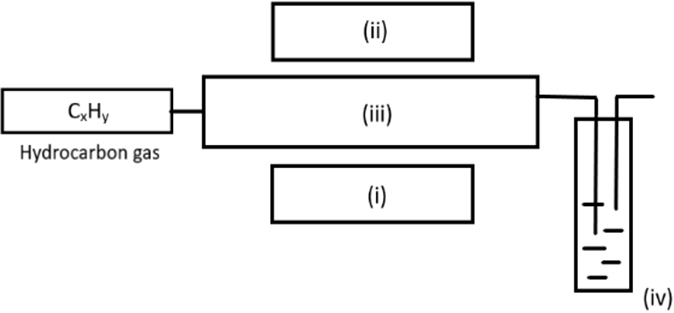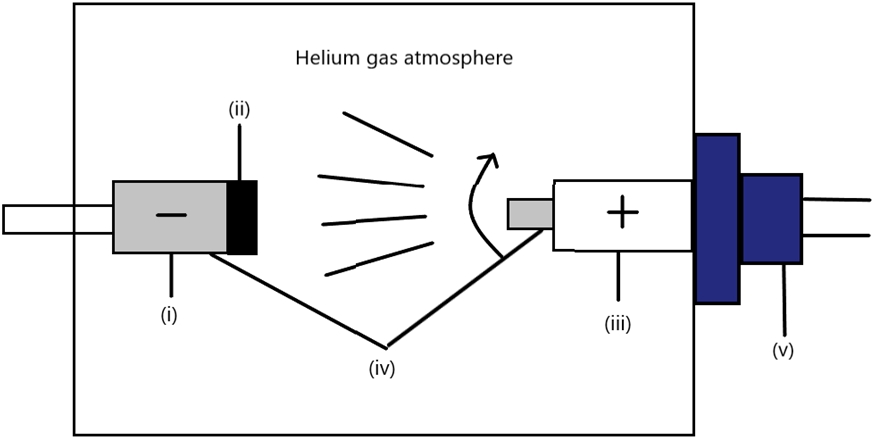This set of Nanotechnology Multiple Choice Questions & Answers (MCQs) focuses on “Carbon Nanotubes Synthesis”.
1. Which gas is used in the HiPCO process of CNT synthesis?
a) Carbon dioxide
b) Sulphur dioxide
c) Ozone
d) Carbon Monoxide
View Answer
Explanation: As the name suggests, HiPCO = High-Pressure Carbon Monoxide method uses carbon monoxide gas for CNT synthesis. Here, CO disproportionate, in the presence of clusters of iron catalysts formed institute from iron pentacarbonyl, to give CNTs.
2. Label the marked parts of the given diagram for CVD method of CNT production.

a) (i) = Furnace; (ii) = Bubbler
b) (ii) = Temperature controller;(iv) = Furnace
c) (iii) = Substrate; (iv) = Bubbler
d) (i) = Bubbler; (iii) = Temperature Controller
View Answer
Explanation: In the above given diagram for CVD method of CNT synthesis the marked parts are; (i) = Temperature Controller; (ii) = Furnace; (iii) = Substrate having metal catalyst sites; (iv) = Bubbler.
3. Which of the following is not a downside of the laser ablation method of CNT production?
a) Expensive procedure
b) Requirement of greater laser powers
c) Low scale production
d) Production of uniformly straight CNT
View Answer
Explanation: Laser ablation method is one of the most widely used procedures for CNT production. However, it has several disadvantages. First, this method is economically unsuitable since it requires great laser powers and high purity graphite rods. Second, the quantity of CNT produced per day is very low as compared to arc discharge or CVD. Third, nanotubes formed from this method are not necessarily uniformly straight but may contain branching. Fourth, the tubes are often formed in twisted and tangled ropes or bundles which make the extraction and application of the individual tubes very difficult.
4. Why are metals such as Fe, Co, Ni so commonly used as CNT catalysts?
a) High carbon diffusion rates in the metals
b) Have the capability of forming multiple compounds
c) They exhibit multivalency
d) Low melting points and high equilibrium vapour pressure
View Answer
Explanation: There are certain reasons behind the use of transition metals such as Fe, Co, Ni most commonly as CNT catalysts. First, the carbon is highly soluble in these metals at high temperature. Second, the diffusion rate of carbon in these metals is also high. Third, the melting point of these metals is high and they have low equilibrium vapor pressure. This offers a vast temperature window of CVD for a broad range of CNT precursors.
5. This method of CNT production can capture and remove a greenhouse gas from the atmosphere. Which method is it?
a) Laser Ablation
b) Chemical Vapour Deposition
c) Liquid electrolysis
d) Plasma Arc
View Answer
Explanation: The liquid electrolysis method is a relatively new process for CNT synthesis. In this method lithium oxide formed in-situ can absorb carbon dioxide, if present, and form lithium carbonate
Li2O + CO2 ⟶ Li2CO3
The reactant in this reaction is CO2,
CO2 ⟶ CNTs + O2
Thus, this procedure is a possible technology to capture and remove CO2, a greenhouse gas.
6. Find out the correct statement regarding the Arc discharge method from the following options.
a) A vacuum chamber is present with buffer gases such as He or Ar
b) Platinum electrodes are used in the process
c) A/C voltage is applied across the electrodes
d) Cathode is evaporated and carbon condenses on anode as CNT
View Answer
Explanation: CNT was first discovered using the Arc discharge method. It employs evaporation of carbon electrodes, in electric arcs, that are placed at proximity to each other. Here, a DC voltage is applied across the electrodes while the chamber is heated to about 4000°C. The anode evaporates and carbon condenses on the cathode as CNT.
7. Find out from the following options a disadvantage of the thermal plasma method used for CNT production.
a) Economical
b) Less-energy consuming
c) Amorphous carbon formation
d) Continuous process
View Answer
Explanation: Thermal plasma method is used for the synthesis of single-walled carbon nanotubes. This procedure is quite efficient, economical, continuous and less energy consuming than arc discharge or laser ablation methods. However, this method produces impure SWCNTs comprising of metallic nanoparticles and amorphous carbon.
8. Why is alumina a better catalyst support than silica?
a) Stronger metal-support interactions
b) Lower metal dispersion
c) Lesser density of catalytic sites
d) Aggregation of metal species
View Answer
Explanation: Alumina materials happen to be a better catalyst-support than silica owing to their stronger metal-support interactions. This permits high metal dispersion and thus a higher density of catalytic sites. These interactions in turn inhibit the aggregation and formation of metallic species and unwanted large clusters respectively, which result in graphite formation or defective MWCNTs synthesis.
9. Who developed the laser ablation method for synthesis of CNT?
a) Richard Smalley and co-workers
b) Adre Geim and Kostya Novoselov
c) Iijima and co-workers
d) Krätschmer and Huffman
View Answer
Explanation: The laser ablation method is used for the production of high quality CNTs that have little structural defects. This method was first developed by Dr. Richard Smalley and his co-workers at the Rice University. They used a laser beam to blast a graphite block in order to create multi-walled carbon nanotubes (MWCNTs).
10. Label the marked parts of the given diagram for Arc Discharge method of CNT production.

a) (i) = Anode; (ii) = Rotary feed through unit
b) (iii) = Cathode; (i) = Anode
c) (iv) = Graphite electrode; (iii) = RHEED GUN
d) (ii) = CNT; (v) = Rotary feed through unit
View Answer
Explanation: In the above diagram for Arc Discharge method of CNT production the marked parts are; (i) = Cathode; (ii) = CNT; (iii) = Anode; (iv) = Graphite electrode; (v) Rotary feed through unit.
11. Which group of metals are mostly used in CNT catalization?
a) Alkali metals
b) Transition metals
c) Alkaline earth metal
d) Radioactive metal
View Answer
Explanation: For synthesizing CNTs, transition metals such as Fe, Co, Ni are typically used to enable hydrocarbon decomposition at a lower temperature than the spontaneous decomposition temperature of the hydrocarbon. Apart from the popular transition metals, other metals of this group such as Copper, Gold, Platinum, and Palladium have also been found to catalyse CNT growth from multiple hydrocarbons.
12. Choose the incorrect statement from the following options with respect to CVD.
a) Liquid as well as solid hydrocarbons are used
b) Only SWCNTs can be produced by this method
c) CNTs can grow on a variety of substrates
d) Catalyst particles stay both at the tip and base of nanotubes
View Answer
Explanation: CVD method of CNT production produces highly pure nanotubes. The method makes use of either liquid or solid hydrocarbons. Here, the CNTs grow at the catalytic sites. The catalyst particles can stay both at the tip and even at the base of the growing nanotubes, depending on the adhesion between the catalyst particles and the substrate. One of the benefits of this method is that both SWCNT and MWCNT can be synthesized and they can be grown on different substrates.
Sanfoundry Global Education & Learning Series – Nanotechnology.
To practice all areas of Nanotechnology, here is complete set of 1000+ Multiple Choice Questions and Answers.
If you find a mistake in question / option / answer, kindly take a screenshot and email to [email protected]
